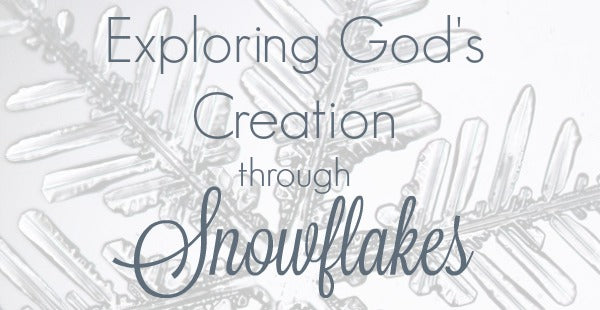Exploring God's Creation Through Snowflakes

“If a rain cloud encounters a stratum of air cold enough to freeze, then what would have been rain or mist comes down to us as sleet, hail, or snowflakes; and of all the forms of water crystals, that of snow in its perfection is the most beautiful; it is, indeed, the most beautiful of all crystals that we know. Why should water freezing freely in the air so demonstrate geometry by forming, as it does, a star with six rays, each set to another, at an angle of 60 degrees? And as if to prove geometry divine beyond cavil, sometimes the rays are only three in number a factor of six and include angles of twice 60 degrees. Moreover, the rays are decorated, making thousands of intricate and beautiful forms; but if one ray of the six is ornamented with additional crystals the other five are decorated likewise. Those snow crystals formed in the higher clouds and, therefore, in cooler regions may be more solid in form, the spaces in the angles being built out to the tips of the rays, and including air spaces set in symmetrical patterns; and some of the crystals may be columnar in form, the column being six-sided. Those snow crystals formed in the lower currents of air, and therefore in warmer regions, on the other hand, show their six rays marvelously ornamented. The reason why the snow crystals are so much more beautiful and perfect than the crystals of hoar frost or ice, is that they are formed from water vapor, and grow freely in the regions of the upper air. Mr. W. A. Bentley, who spent many years photographing the snow crystals, found nearly 5,000 distinct designs.” - Handbook Of Nature Study pages 809-810
 Snow, the frozen crystal form of water, is amazing. It is beautiful to look at blanketing the ground, but even more stunning up close. Its six sided form is a lesson in molecular chemistry and geometry.
The six sides of a snow crystal are caused by water’s molecular structure. Its two hydrogen atoms flank its one oxygen atom at an angle that forms a “V’ shape. The hydrogen end of the water molecule is slightly negatively charged, while the oxygen end is slightly positively charged.
Snow, the frozen crystal form of water, is amazing. It is beautiful to look at blanketing the ground, but even more stunning up close. Its six sided form is a lesson in molecular chemistry and geometry.
The six sides of a snow crystal are caused by water’s molecular structure. Its two hydrogen atoms flank its one oxygen atom at an angle that forms a “V’ shape. The hydrogen end of the water molecule is slightly negatively charged, while the oxygen end is slightly positively charged.
 The polarity and shape of water molecules cause them to bond to each other in such a way that they form a specific pattern with six-sided symmetry. You can see this symmetry in each and every snowflake.
Other molecules have the same type of symmetry and can form crystals when they bond together. When you are learning about snow, sometimes it is interesting to study these other kinds of crystals.
The polarity and shape of water molecules cause them to bond to each other in such a way that they form a specific pattern with six-sided symmetry. You can see this symmetry in each and every snowflake.
Other molecules have the same type of symmetry and can form crystals when they bond together. When you are learning about snow, sometimes it is interesting to study these other kinds of crystals.












